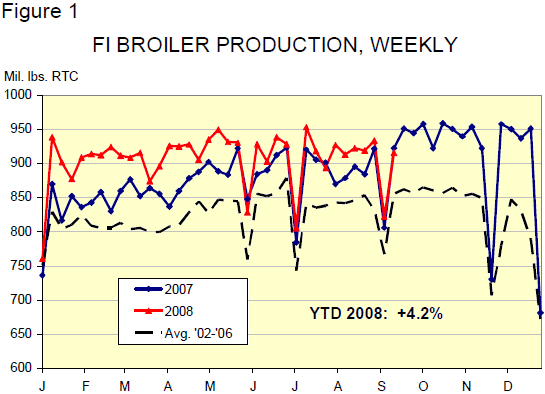



CME: Broiler Output Lower Than in 2007
US - CME's Daily Livestock Report for 22 September 2008.A key factor in fourth quarter livestock and poultry markets will be the total amount of meat offered by US producers, packers and processors — and that figure is getting closer and closer to year-ago levels. As can be seen in the chart below, the first half of 2008 saw total animal protein offerings that were much larger than those of 2007, exceeding year-ago levels by 5.7% through the end of June.
Since that time, production has moderated versus the normal seasonal pattern and last year’s levels. In fact, last week’s year-on-year increase of 0.45% was the smallest for a non-holiday week since June 7, 2007. But any conclusion that supplies are drying up must be tempered due to last year’s comparison base, which grew dramatically when hog slaughter jumped in September as a result of effective circovirus vaccines. Still, we must remember that hog prices held together surprisingly well under that onslaught of record numbers, so any reductions this year would be encouraging, especially given exceptional pork and poultry exports and growing beef exports. Note that the chart below includes veal, lamb, hens and turkey.

Charts for the three major components of US meat and poultry production — young chicken (or broilers), pork and beef (please see below) are approaching last year from the top to some degree.



Weekly broiler production began the year 3-11% higher than in 2007. Record high broiler prices in 2007 had kept broiler companies growing aggressively even as feed costs had risen. After falling in Q4-’07, prices rebounded in early 2008 just as soybean meal prices fell relative to corn prices, providing some competitive advantage to broiler producers. Any profits provided by that advantage were short-lived, though, as feed costs soared in June and broiler producers began to reduce chick placements and egg sets. Those reductions have taken hold and last week’s production figure was the second non-holiday week this year in which broiler output was lower than in 2007. It appears more reductions are coming since egg sets have been over 4% lower in several recent weeks.
Pork production, year-to-date (YTD), is still up a robust 8.8% but the past two weeks, at +1.2% and +2.4%, have been closer to year-earlier levels than any this year. This is the meat for which the “year-ago” trap could catch us most severely since these small percentage increases are on top of record output levels in 2007. Can exports remain high enough to decrease domestic supplies by 10-20% as they have done thus far in 2008? This Friday’s USDA Hogs and Pigs Report will provide us a fresh idea of what fall supplies may be.
Finally, beef production has bounced around year-ago levels since early June after being almost 3.5% higher, year-to-date, in late May. Continued lower feedlot placements should keep steer and heifer slaughter below year-ago levels—-as it has been for the past 14 weeks, over which time steer and heifer slaughter has been 4% lower than last year. A good portion of that reduction, though, will be offset by higher beef cow slaughter which was 18% larger last week vs. 2007 and is up 13% YTD.








